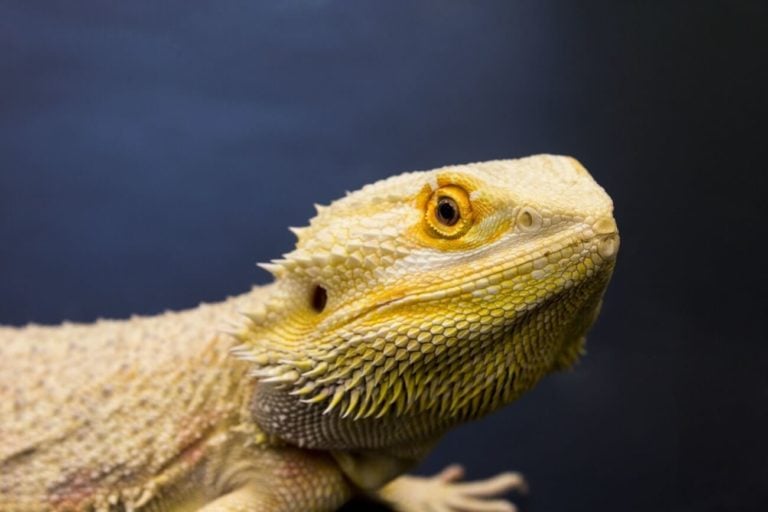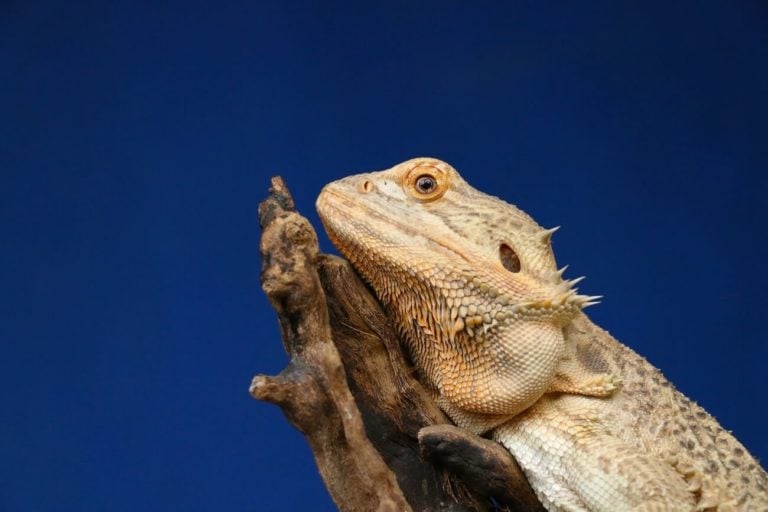The most intelligent reptiles are actually quite different from one another! You have lizards, tortoises, and snakes all represented on the list.
This list of the smartest reptiles will take your herpetology education to the next level, and give you an added sense of appreciation for these animals.
1. Monitors
Monitor lizards are considered by many in the zoology world to be one of the most intelligent reptiles on the planet. They’re also one of the most intimidating!
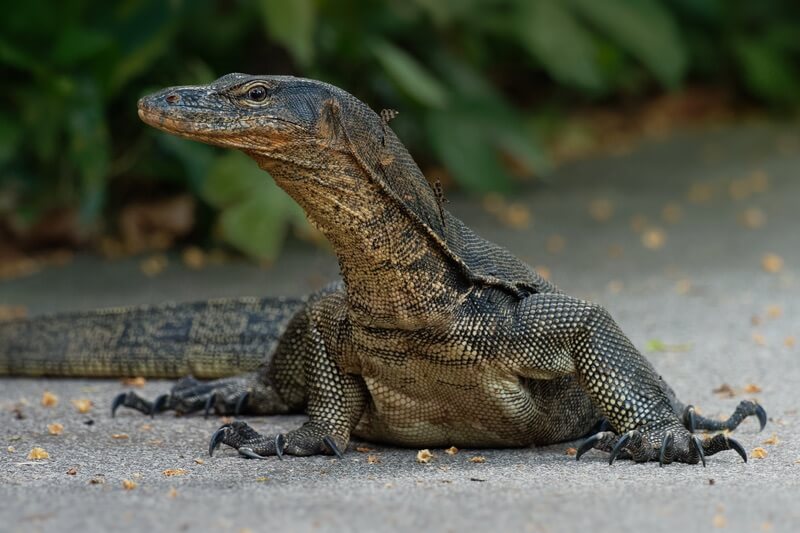
The most well-known species is the Komodo dragon. It reaches lengths of over ten feet! Smaller monitors are only about a foot long. Regardless of their size, monitor lizards display some impressive feats of intelligence.
A study at the San Diego Zoo found that monitors can count a small collection of items. The experiment conditioned snails to expect a certain number of snails in a chamber. When there were fewer snails than usual, they would continue to search for the rest!
The unique trial discovered that monitors could count up to around six objects, which is impressive for any reptile.
Other feats of intelligence include the ability to recognize keepers and owners and target objects. These skills come in handy when kept in captivity. Zoos often employ a team of dedicated handlers that monitors can learn to recognize and become comfortable around.
Then, they use the targeting behaviors to distract monitors as they undergo health observation and treatment.
Some monitor lizards also display their smarts when trying to access hard-to-reach food. These smart reptiles can learn to use their forearms when extracting insects from logs and other tight spaces.
These smart lizards are fascinating to watch as well. They’re native to the Oceania region, Asia, and Africa. However, many herpetology lovers around the world keep them as pets, too.
2. Giant Tortoises
Don’t let their slow speed fool you. Many Chelonians are very intelligent reptiles. From the majestic sea turtle to lowly pond sliders, these reptiles have a lot more going on in their minds than they let on.
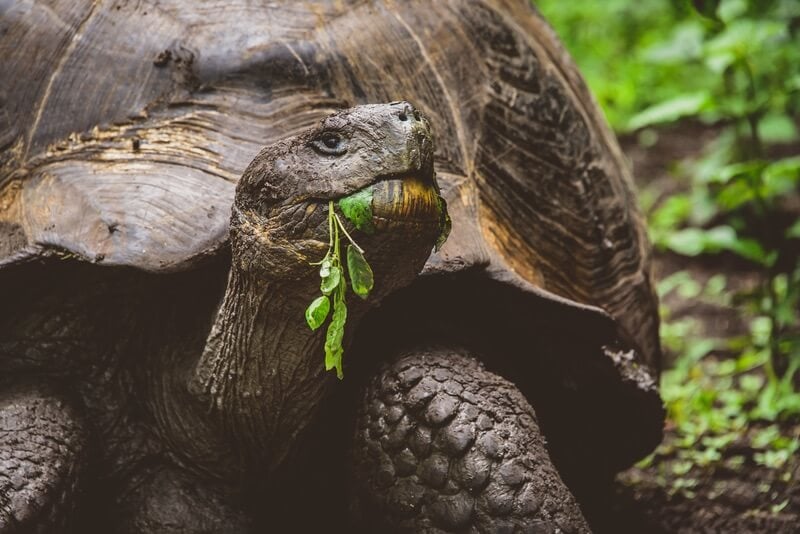
Giant tortoises are, perhaps, the most intelligent reptiles of the bunch. The gentle giants originate from the Galapagos Islands. There, these tortoises were famously studied by Charles Darwin.
There are several giant tortoise species out there. The biggest can tip the scales at 700 pounds and live for over 100 years. But that’s not the most impressive thing about them.
In Jerusalem and Vienna, two separate studies tested the cognitive abilities of these tortoises. They were virtually identical in terms of methodology. The core difference was that one study involved a group of giant tortoises while the other involved individuals.
In these experiments, handlers taught Galapagos and Aldabra giant tortoises to bite on colored balls. The tortoises eventually learned how to distinguish between three different colors and bite the correct option each time.
What’s even more fascinating is that the tortoises remembered these skills for a long time. They were given the same challenge a full nine years later and still remembered how to bite on the correct ball!
Not only are giant tortoises very smart reptiles, but they clearly hold onto experiences for years. Interestingly enough, the tortoises that trained in groups learned the skills faster than those trained individually. As a result, tortoises may also hold collaborative learning capabilities.
3. King Cobra
The king cobra is a large poisonous snake native to tropical areas in Africa and the southern parts of Asia. Instantly recognizable thanks to their foreboding hood, king cobras truly are royalty in the reptile kingdom. Not only are they incredibly dangerous, but they have the intelligence to be an apex predator.
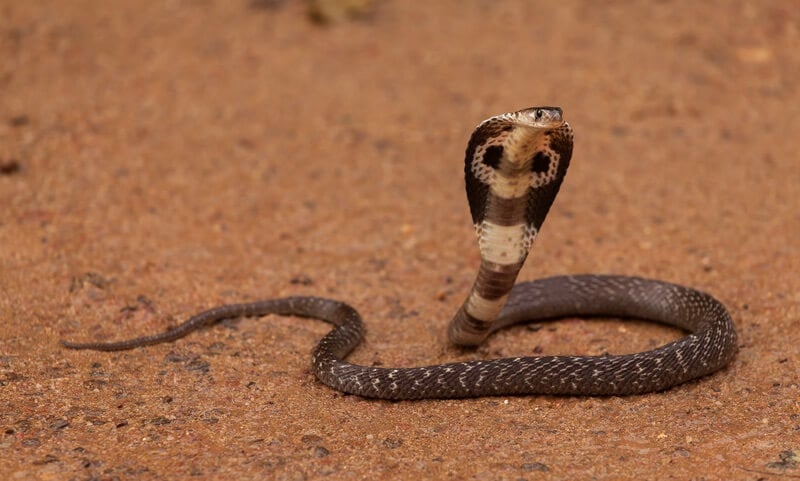
From pure appearance alone, king cobras are a sight to behold. Adults have smooth, dark-colored scales with white or yellow banding. The head and hood are usually yellow, which creates gorgeous contrast.
Despite this snake’s beauty, consider yourself fortunate if you never come across a king cobra in real life! These snakes have hollow fangs to inject venom into prey. The neurotoxins they deliver in a single bite are enough to kill 20 adults or a full-grown elephant!
What makes king cobra snakes even scarier is how meticulous and smart they are about taking down prey. Most species respond to sound or strike out of pure reactionary instincts. That’s not the case with this snake.
King cobras take a second to determine the best course of action. They study their prey and figure out the best spot to inject their venom. The reptile is all about efficiency.
Other signs of intelligence include their ability to climb trees and swim through water. In captivity, these snakes have also shown signs of recognizing frequent handlers.
4. Snapping Turtle
Earlier, we talked about how intelligent the biggest Chelonians were. However, the common snapping turtle is pretty sharp, too.
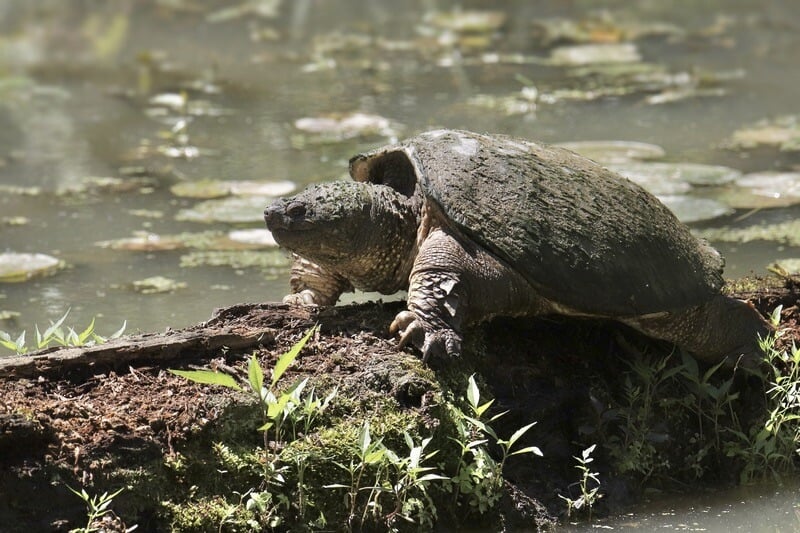
Snapping turtles are a widespread reptile native to North America. They’re widespread and can live in a wide range of environments.
The turtle’s adaptability is thought to be a byproduct of great cognitive ability. These reptiles can live in dry areas, wet marshes, and everywhere in between. Regardless of where they live, snapping turtles have a knack for getting to safety and making due.
Another exciting piece of evidence about their intelligence is how determined they are to escape captivity! From small turtle tables to large pond enclosures, these reptiles will work tooth and nail to try and escape. Keepers often observe them climbing high points or burrowing through the mud to take advantage of any vulnerability.
The fact that snapping turtles also learn how to spot their food containers is more proof that they are one of the smartest reptiles around. They can identify them by sight. Not only that, but these reptiles can recognize the sound of food being poured into the containers even when they cannot see them.
Those behaviors might seem simple enough, but most reptiles don’t exhibit that level of familiarity.
If a domesticated turtle ends up getting released back into the wild, they’ll almost always head straight for the nearest body of water. No matter how far away it is, snapping turtles will steer in that direction.
5. Frill-Neck Lizard
Popularized by movies and cartoons, the frill-neck lizard has a very distinct look. It’s also known as the frilled dragon and frilled agama. Whatever you call it, these lizards are easy to identify thanks to a section of thin skin that folds over the shoulder.
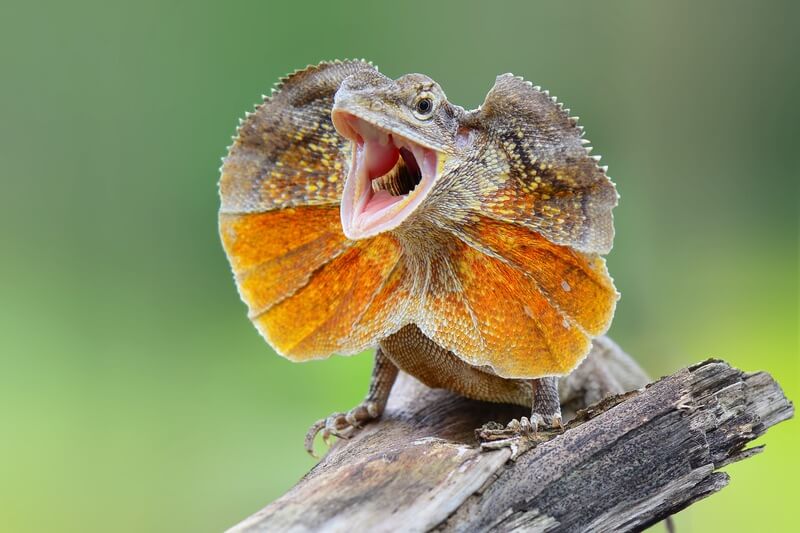
At first glance, you probably wouldn’t notice the frill. These smart lizards are pretty hard to spot in the wild because of their impressive camouflage. Plus, they’re arboreal and spend a lot of time in trees.
Their bodies are usually brown or gray, making it easy for them to blend into the tree branches they climb.
If you happen to disturb or threaten the lizard, their intelligence and ferocity come out in full force!
The frill opens and pops up to create an almost dinosaur-like appearance. It extends like a collar around the neck. Because the extra skin is usually lighter than the rest of the body, it stands out!
This unique defense mechanism helps to make the lizard seem bigger, which tends to scare off most animals.
If the disturbance doesn’t flee in fear, frill-neck lizards will take things a step further! They’ll stand on their hind legs like a human and run away. Sometimes, they’ll charge at other would-be predators directly!
Frill-neck lizards are anything but slow. They can reach top speeds of almost 30 miles per hour! The lizard’s ability to intimidate is a clear sign of intelligence and strategy.
6. Emerald Anole
Last but not least, we have the emerald anole. Also known as the green anole, these small lizards are native to North, Central, and South America. They tend to stick around tropical and humid areas.
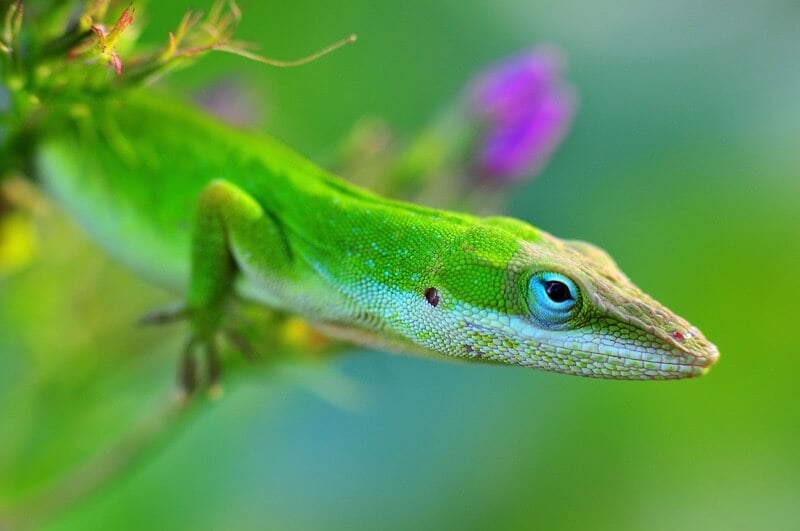
Along with other anole species, emeralds are prized pets in many parts of the world. However, they run rampant in the wild as well. If you happen to live in the Southern United States, there’s a good chance you’ll find a few inhabiting your backyard!
It’s no mystery why herpetology enthusiasts love to raise emerald anole. They are a small species that measures only a few inches in size. The skin is vibrant green and eye-catching.
Emerald anole also has a bright-colored dewlap. Usually pink or white, the anole will extend the flap of skin when mating or showing signs of aggression. It’s a form of simple communication that conveys emotions among the species and sends warnings to other animals.
These small pet lizards show cognitive abilities that fall in line with birds and mammals. A study at Duke University tested the emerald anole’s ability to find insect larvae.
The larvae were hidden under plastic disks. Despite the obstacle, the anoles were able to find the food!
Another sign that they’re one of the most intelligent reptiles is their penchant for evading harm. Emerald anoles do not like being handled! They’ll go to extreme measures to wriggle out of your hand or the mouth of a predator.
The lizard strategically drops its tail to escape harm. While the tail never goes back to normal, emerald anoles can regrow it and continue using it to get out of harm’s way.

